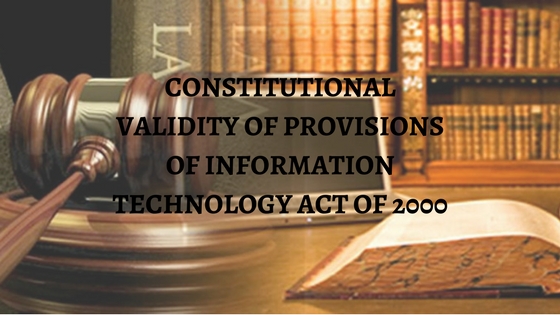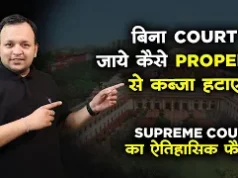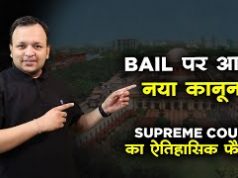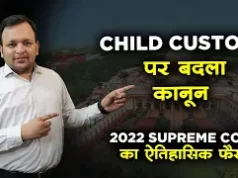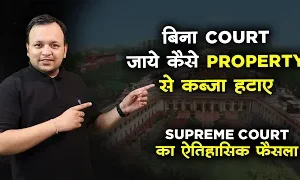Aapka Consultant Judgment Series- In this series, we are providing case analysis of Landmark Judgments of Hon’ble Supreme Court of India.
Shreya Singhal Vs. Union of India
AIR2015SC1523, (2015)5SCC1, 2015 (4) SCJ 283
Hon’ble Judges/Coram: Jasti Chelameswar and Rohinton Fali Nariman, JJ.
Date of Decision: 24.03.2015
FACTS:-
This batch of writ petitions filed under Article 32 of the Constitution of India raises very important and far-reaching questions relatable primarily to the fundamental right of free speech and expression guaranteed by Article 19(1)(a) of the Constitution of India. The immediate cause for concern in these petitions is Section 66A of the Information Technology Act of 2000 (hereinafter referred as ‘the Act’). This Section was not in the Act as originally enacted, but came into force by virtue of an Amendment Act of 2009 with effect from 27.10.2009. The petitioners’ various counsel raised a large number of points as to the constitutionality of Section 66A. According to them, first and foremost Section 66A infringes the fundamental right to free speech and expression and is not saved by any of the eight subjects covered in Article 19(2). According to them, the causing of annoyance, inconvenience, danger, obstruction, insult, injury, criminal intimidation, enmity, hatred or ill-will are all outside the purview of Article 19(2). Further, in creating an offence, Section 66A suffers from the vice of vagueness because unlike the offence created by Section 66 of the same Act, none of the aforesaid terms are even attempted to be defined and cannot be defined, the result being that innocent persons are roped in as well as those who are not. The enforcement of the said Section would really be an insidious form of censorship which impairs a core value contained in Article 19(1)(a). In addition, the said Section has a chilling effect on the freedom of speech and expression. Also, the right of viewers is infringed as such chilling effect would not give them the benefit of many shades of grey in terms of various points of view that could be viewed over the internet.
ISSUE:-
- Whether Section 66A of the Act is constitutionally valid or not?
JUDGEMENT:-
The Preamble of the Constitution of India inter alia speaks of liberty of thought, expression, belief, faith and worship. It also says that India is a sovereign democratic republic. It cannot be over emphasized that when it comes to democracy, liberty of thought and expression is a cardinal value that is of paramount significance under our constitutional scheme.
Having said that, the Court looked into content of the expression “freedom of speech and expression”. There are three concepts which are fundamental in understanding the reach of this most basic of human rights. The first is discussion, the second is advocacy, and the third is incitement. Mere discussion or even advocacy of a particular cause howsoever unpopular is at the heart of Article 19(1)(a). It is only when such discussion or advocacy reaches the level of incitement that Article 19(2) kicks in. It is at this stage that a law may be made curtailing the speech or expression that leads inexorably to or tends to cause public disorder or tends to cause or tends to affect the sovereignty & integrity of India, the security of the State, friendly relations with foreign States, etc.
Court observes that the public’s right to know is directly affected by Section 66A. Information of all kinds is roped in – such information may have scientific, literary or artistic value, it may refer to current events, it may be obscene or seditious. That such information may cause annoyance or inconvenience to some is how the offence is made out. It is clear that the right of the people to know – the market place of ideas – which the internet provides to persons of all kinds is what attracts Section 66A. That the information sent has to be annoying, inconvenient, grossly offensive etc., also shows that no distinction is made between mere discussion or advocacy of a particular point of view which may be annoying or inconvenient or grossly offensive to some and incitement by which such words lead to an imminent causal connection with public disorder, security of State etc. In light of this, court was of opinion that the petitioners are right in saying that Section 66A in creating an offence against persons who use the internet and annoy or cause inconvenience to others very clearly affects the freedom of speech and expression of the citizenry of India at large in that such speech or expression is directly curbed by the creation of the offence contained in Section 66A.
The U.S. Supreme Court has repeatedly held in a series of judgments that where no reasonable standards are laid down to define guilt in a Section which creates an offence, and where no clear guidance is given to either law abiding citizens or to authorities and courts, a Section which creates an offence and which is vague must be struck down as being arbitrary and unreasonable. Incidentally, none of the expressions used in Section 66A are defined. Even “criminal intimidation” is not defined – and the definition clause of the Information Technology Act, Section 2 does not say that words and expressions that are defined in the Penal Code will apply to this Act`. Every expression used is nebulous in meaning. What may be offensive to one may not be offensive to another. What may cause annoyance or inconvenience to one may not cause annoyance or inconvenience to another. Even the expression “persistently” is completely imprecise – suppose a message is sent thrice, can it be said that it was sent “persistently”? Does a message have to be sent (say) at least eight times, before it can be said that such message is “persistently” sent? There is no demarcating line conveyed by any of these expressions – and that is what renders the Section unconstitutionally vague. It is clear that Section 66A arbitrarily, excessively and disproportionately invades the right of free speech and upsets the balance between such right and the reasonable restrictions that may be imposed on such right.
That apart, Court further observed that the Section is unconstitutional also on the ground that it takes within its sweep protected speech and speech that is innocent in nature and is liable therefore to be used in such a way as to have a chilling effect on free speech and would, therefore, have to be struck down on the ground of overbreadth.
HELD:-
- Section 66A of the Information Technology Act, 2000 is struck down in its entirety being violative of Article 19(1)(a) and not saved under Article 19(2).
- Section 69A and the Information Technology (Procedure & Safeguards for Blocking for Access of Information by Public) Rules 2009 are constitutionally valid.
- Section 79 is valid subject to Section 79(3)(b) being read down to mean that an intermediary upon receiving actual knowledge from a court order or on being notified by the appropriate government or its agency that unlawful acts relatable to Article 19(2) are going to be committed then fails to expeditiously remove or disable access to such material. Similarly, the Information Technology “Intermediary Guidelines” Rules, 2011 are valid subject to Rule 3 sub-rule (4) being read down in the same manner as indicated in the judgment.To Get Legal Opinion from Advocates/ Legal Experts, Please click here
To Get Legal Opinion from Retired Hon’ble Judges, Please click here



